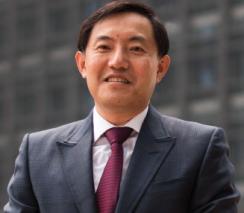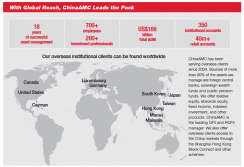
Previously China’s “domestic investors paid little attention to asset allocation,” Tang told Institutional Investor during a July 5 interview in Beijing. “But now asset allocation – the ‘bread and butter’ of international investment – is becoming more popular.”
“People are beginning to believe in asset allocation.”
They’re also believing in ChinaAMC, which in June reported a China market-leading US$165.83 billion in total assets under management. And they’re trusting Tang at the wheel, now that he’s steered the firm through bad times as well as good.
ChinaAMC weathered the storm while retaining its position as the nation’s No. 1 asset manager by AUM in 2015. The firm also emerged with a stronger-than-ever reputation as a reliable provider of long-term investment tools for international and domestic clients.
Today’s China is “an exciting market for sophisticated asset managers,” Tang said.
ChinaAMC’s sophistication stands in sharp contrast to the folly of firms with wildly high yield offers. Before the stock sell-off, through risky equity products offered by some asset managers, “anyone, the cab driver, the hair dresser, could play the market and get a 70, 80 percent return,” he said.
ChinaAMC did not match those irrational yet popular retail products. “We did not want to compete solely on return without risk consideration,” Tang said.
“Then came a bear market and a lot of people suffered substantial losses,” he said. “Investors started to take into account diversification and risk-reward in their investment decisions. It’s a great opportunity for asset managers like us.”
For domestic and international institutional investors, it’s also a great opportunity rooted in China’s robust investment climate, a market regulation system that encourages innovation, ample liquidity, and a slowing yet still growing blockbuster of an economy. Corporate governance, market access and transparency issues that have long cast a shadow over foreign investor interest in China are gradually being addressed. And because the sell-off tempered risk appetite, the playing field is now less cluttered and the remaining players more mature.
ChinaAMC has always taken the high road in its role as an adviser and service provider for a wide range of market participants, from overseas institutional investors including sovereign wealth funds, central banks and public pension funds that access China’s stock market through the Qualified Foreign Institutional Investor (QFII) and Renminbi Qualified Foreign Institutional Investor (RQFII) programs, to government officials in Beijing who supervise the financial sector. Tang said his firm in recent years “has been playing an active role” at the forefront of the nation’s asset management sector.
“We strive to provide the regulators with constant feedback,” said Tang, who before joining ChinaAMC in August 2014 served at the China Securities Regulatory Commission, which oversees the nation’s stock markets, as deputy director-general at its Department of Fund Supervision and then at the Department of International Affairs.
An MBA graduate of the University of Chicago, Tang also earned dual master’s degrees in computer science and physics from Drexel University in Philadelphia, and a bachelor’s degree in physics from the University of Science and Technology of China in Hefei.
Before joining CSRC in 2009, Tang served as managing director and chief of U.S. corporate correlation trading at RBS Greenwich Capital, and headed U.S. exotic credit derivatives trading at ABN AMRO.
Because ChinaAMC manages “a substantial portion of the assets” flowing into China through the QFII program “we receive feedback from our investors, and we pass on the suggestions to the securities regulators,” Tang said.
Tang said based on his Wall Street experience during the U.S. subprime mortgage crisis of 2007 and subsequently the global financial meltdown of 2008, he could sense China’s coming storm in early 2015. “The market was becoming more and more irrational,” he said. “We held frequent internal meetings to discusscontingency plans and implemented measures to manage the liquidity of the funds. During the crisis, we had a constant dialogue with the regulators, providing them with real-time market information and suggestions.”
“My diverse experience has enabled me to communicate effectively with different players in the market, from foreign institutional investors, to domestic regulators and investors,” Tang said. “The financial market in China is a welcoming place for people with international experience. I have personally benefitted from the openness and rapid growth of the asset management industry in China.”
Also on the receiving end of Tang’s and ChinaAMC’s communication line is the stock exchange indexer MSCI Inc., which disappointed the China market recently by declining, at least for now, to add the country to its influential Emerging Markets Index. MSCI has laid out a roadmap for China financial system reform in hopes its A-share market can qualify for the index in the future. Meanwhile, according to Tang, ChinaAMC “is communicating with MSCI, and explaining to them the substantial progress that has been made by the regulator.”
MSCI inclusion is inevitable, Tang said confidently. “It’s only a matter of time.”
The A-share market is simply too big and too important for international investors to ignore. And by encouraging foreign investment in China, Tang said, ChinaAMC is indirectly paving the way for MSCI inclusion by means of the international institutional investor’s ability to “influence the capital market, improve transparency, (and) promote value-based investment.”
“Having a solid institutional investor base is crucial,” Tang said, “What we truly need is long-term and value-oriented capital.”
In the past year there’s been a philosophical shift among China investors from high-risk, leveraged products to more rational, diversified investing that mirrors major institutional investor strategies.
“A lot has changed,” Tang said. “On the regulatory side, you see more measures to promote market stability. On the product offering side, they (regulators) are paying more attention to embedded leverage and investor suitability.”
ChinaAMC has made a deliberate decision not to offer some of the complicated but popular retail products on the domestic market. One such product called a “split fund” was also known as a “leverage fund,” Tang said, because it was subject to a deleveraging mechanism that, when triggered, could slash 50 to 60 percent of an investor’s principle in one day. About 70 percent of the investor complaints filed with market regulators at that time revolved around split funds, he said. “We were one of the very few asset managers that did not offer the product,” Tang said. “It really enhanced our reputation.”
By holding its ground, Tang said, ChinaAMC’s product specialists were “free to design funds that offer better risk-adjusted returns to our investors.” And that trend is continuing now that the equities market is recovering, China’s bond market is maturing, and the economy is continuing to grow, albeit more slowly than a decade ago.
Consider, for example, the firm’s decision to reach out to institutional investors. About 70 percent of China’s money market funds are now targets for institutional investors, even though a little over a year ago retail investors dominated that sector. ChinaAMC is thus “rallying our sales team to broaden relationships with institutional investors” including banks, insurance companies and the financial arms of various companies, he said.
“We have established good relationships with the wealth management divisions of commercial banks in China that have amassed assets worth more than US$4 trillion,” Tang said. Before the sell-off, wealth management products were able to offer attractive fixed return by providing margin lending for stock purchases. Regulators later imposed rules that put a damper on the practice.
“Subsequently, we came up with alternative solutions. We showcased our fixed-income product offerings and provided asset allocation strategies to clients of ours who are searching for stable yield in the new market environment.”
ChinaAMC is also cultivating relationships with major overseas financial firms with the goal of providing clients with a broader mix of asset allocation strategies. For example, Tang said his firm has teamed up with PanAgora Asset Management, a quantitative shop in Boston. “PanAgora’s specialty is in risk parity portfolio construction. It’s been proven in the U.S,” he said. “It’s our thesis... that risk parity methodology could work better in China than in the U.S.”
“China is still in the loosening monetary policy regime,” he continued. “On the fixed income side, the yield still has the potential to come down further. And on the equity side, the valuations are becoming more attractive.”
“We believe that asset allocation decision-making will be the focus of the investment community in China.”
Factoring into that forecast is Tang’s overall outlook for China, which is sometimes portrayed as a slowly declining economy rather than what it is – a strong economy that’s growing more slowly than in years past.
“We’ve noticed that, geographically, the farther away you are from China, the more pessimistic you become,” Tang said. “Domestic institutional investors are quite confident about the strength of the economy, and market conditions have improved.”

“The Chinese economy and Chinese capital market are playing an influential role on the global financial market,” he said. “What’s happening in China will have a ripple effect around the world.”
“In the long run, I am very optimistic about the growth of the economy. China has a solid consumer base and a rapidly growing middle class,” Tang said. “The service industry in China is maturing, and as this trend continues the service industry will be able to capture the enormous spending power of the middle class.”
“The demand is there. That’s a luxury that not a lot of countries have.” It’s a luxury that Tang and his ChinaAMC colleagues are not only enjoying but actively cultivating for clients in China, with the goal of leading the domestic industry through good times and bad, for a long time to come.
“We see ourselves as a regional leader, based in China, specializing in China-related markets,” Tang said. “We’re a China specialist.”
CONTACT US
Email: international@ChinaAMC.com
Website: http://www.chinaamc.com
Linkedin: http://www.linkedin.com/company/china-asset-management-company






